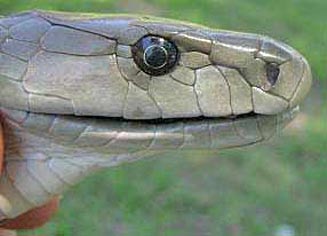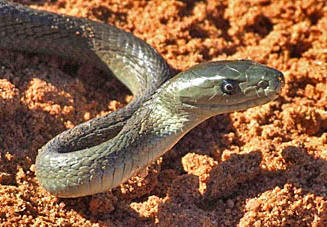|
Dendroaspis polylepis (Black mamba, Southern brown mamba)
Swart mamba [Afrikaans]; iMamba [Xhosa]; iMamba ennyama [Zulu
& Ndebele]; Mokopa [Tswana & North Sotho]; Khangala [Venda]; Hangara [Shona]
Life >
Eukaryotes
>
Opisthokonta >
Metazoa
(animals) > Bilateria > Deuterostomia >
Chordata >
Craniata > Vertebrata (vertebrates) > Gnathostomata (jawed vertebrates) >
Teleostomi (teleost fish) > Osteichthyes (bony fish) > Class:
Sarcopterygii (lobe-finned fish) > Stegocephalia (terrestrial vertebrates) >
Tetrapoda
(four-legged vertebrates) > Reptiliomorpha > Amniota >
Reptilia (reptiles) >
Romeriida > Diapsida > Lepidosauromorpha > Lepidosauria >
Squamata > Serpentes
(snakes) > Family: Elapidae > Genus:
Dendroaspis
 Dendroaspis polylepis (Black mamba, Southern brown mamba),
Mpumalanga [M. Douglas & C. Hobkirk ©, from
SARCA
Virtual Museum] |
 Dendroaspis polylepis (Black mamba, Southern brown mamba),
Limpopo [G.Tomsett ©
from
SARCA
Virtual Museum] |
Identification
The Black mamba can be identified by the following
features, a uniform olive brown or grey body, a coffin shaped head, a black
throat lining (which gives it its name), its jaws forming a "smile" and
its ability to move with a third of its body of the ground. It is important to
note that snake is only
active during the day. This snake usually averages 3 meters but may reach up to
4.5 meters. This snake is strictly diurnal
Distribution and habitat
This snake has a fairly confined distribution in South
Africa only occurring northern KwaZulu-Natal, Mpumalanga and Limpopo, However it is
widespread in the following locations Swaziland, southern Mozambique, Zimbabwe,
Botswana and a large portion of Namibia. Its preferred habitat includes
the following,
termite
mounds, hollow tree trunks and small hillocks in lowland forest or savanna. It
is important to note that it can also climb into trees or shrubs.
Food
Primarily feeds on
rodents,
squirrels,
hyraxes (dassies)
and fledgling birds.
Predators, parasites and disease
Has very few animals which feed on it, however
it is occasionally eaten by other snakes and
birds of prey ( e.g.
Secretary birds and
Snake eagles).
Juveniles can be eaten by a variety of predators such as Red-billed hornbill -
see image.
Reproduction
Oviparous (egg laying), laying
between 10 and 25 eggs which are laid approximately 55 days after mating (
during which the males will engage in combat) takes place in late spring or
early summer.
Longevity
Has been known to live for up to 20
years.
Medical importance
Produces a powerful neurotoxic venom,
which although less powerful than the Cape cobra's is more deadly. This is
because of the snake's ability to inject large quantities of venom and because
its height enables it to inject venom at chest level. it is for these reasons
that the Black mamba has the title of being Africa's most deadly snake, This in
spite of an antivenom being available.
Links
References
-
Broadley, D.G. 1983. FitzSimons' Snakes of Southern
Africa. Delta Books, Johannesburg.
-
Marais, J. 2004. A Complete Guide to Snakes of
Southern Africa. Struik Publishers, Cape Town.
|
